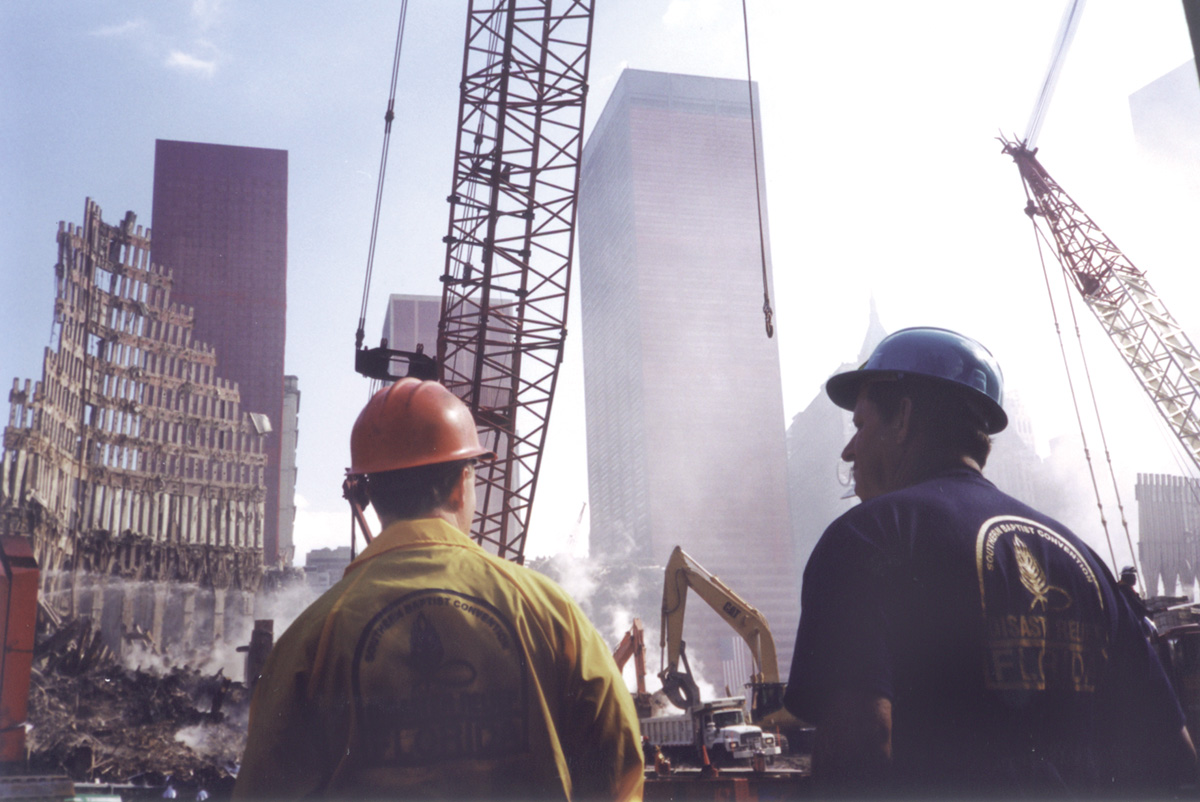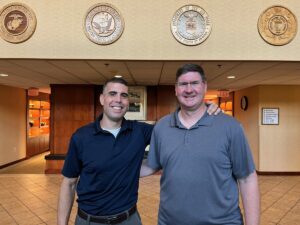
NEW YORK CITY (BP)–Nothing could prepare a team of Florida Baptist disaster relief volunteers stationed two blocks away from ground zero of the World Trade Center disaster for what they would see and feel.
Most of the 16 men had been soldiers in either Vietnam or World War II, but this was a different kind of war, a war that hit home in the heart of the nation’s premier city.
“This is much more severe than I thought,” said John Layman, a member of Olive Baptist Church in Pensacola. A retired engineer, Layman was amazed by the extent heat and fire mushroomed to consume buildings within full city blocks.
“We braced ourselves for what we would see. Some of us knew a little bit about what to expect. I served in Vietnam. Some of us go as far back as World War II. But we still weren’t prepared for the scope of it. We’ve seen death and destruction in war. We’ve had bombs dropped around us. But this is an American city and these were civilians.”
The destruction covers 12 acres and has obliterated about 5 percent of city’s office space, a construction worker from Brooklyn told Layman. The worker saw the towers fall from a skyscraper located across the East River.
Another worker, Jean Claude, an iron and steel specialist who had helped construct the World Trade Center towers, saw the structures fall from a bridge where he was working.
“I never thought I would have to help take it down,” he said. “I had a sense of nostalgia and history when I saw it go down. I had a part in a piece of history and now it’s gone.”
The skeletons of the twin towers are all that remain, leaning on adjacent buildings that also are severely charred and collapsed. Recovery workers continue to uncover fire and smoke as they dig below the surface of smoldering layers of rubble that rise to temperatures exceeding 1,800 degrees. Despite wearing protective masks, several workers have developed persistent coughs as a result of the long hours spent amid the dust and smoke.
Long metal beams from the towers are knifed into the sides of Building Five and the Deutsche Bank on the opposite sides of the block from each other. Two-thirds of the beams are suspended in the air, threatening to eventually give way.
At the bottom of the buildings, craters several stories deep hold untold pieces of steel that look like they were wadded up and stuffed into the ground. On the edge of the bank’s crater, shreds of red carpet wrapped about metal, along with remnants of a resume and a cashed check addressed “One World Trade Center Concourse,” hint at the lives people led in the building.
On the surface, it seems strange that fragile pieces of paper could survive the fire when much sturdier pieces of furniture and metal didn’t. But retired public safety officer Tom McConnell of Sebring, Fla., observed, “It’s like squeezing a bottle of talcum powder and watching bits of it disperse like a cloud, except what carried things through the air were dust, smoke and fire.”
Within the crater in front of the bank, layers of rubble press down on a pocket left partially recognizable as an office desk and an adjoining file cabinet. Though covered with debris and fallen pieces of steel, a computer terminal, keyboard and speakers are visible on a desk that is still upright. Nearby, a file cabinet, upheld by a portion of a ceiling, holds a brown set of files and a blue reference book still balanced on the cabinet.
“When you see something like that, you wonder, ‘Did the people there survive or did they even have a chance when everything came down on them?'” McConnell said.
These questions haunt family members of victims, such as one woman’s desperate inquiry to Navy chaplain William Brown, “Can my brother still breathe under all that?”
Brown escorts family members into ground zero so they can come to grips with their loss.
“Some don’t say anything,” he said. “It’s enough for them to see it with their own eyes and realize their family members are gone from this earth and aren’t suffering anymore.
“Some just can’t get their minds around the reality that there are no survivors left. This is their grave. Some family members must begin to make peace with the fact that we may never find their loved one’s body.”
Memorials to civilian victims and rescue workers who died in the attempt to save them have been established near the Hudson River a block away from the disaster.
Teddy bears, hard hats, flowers, notes and crayon drawings make up the memorials. Posted notes tell of the grief family members bear:
“Dear Dad, I miss you with all my heart. I’m sorry I never got to formally tell you all that you were to me. You will live on in my heart and the hearts of my two little ones. I’ll try to live in a manner that’s worthy of your honor. Mom misses you and can’t wait to see you again. We’re all waiting for the time we can join you and we’ll be a complete family again. Love, Ashley.”
“Praise and thanksgiving for the life of Matthew Sellitto, age 23, Cantor Fitzgerald, 105th floor.”
At the rescue worker memorial across the street, a newspaper drawing on an editorial page is redrawn by children depicting a firefighter and a police officer standing tall over the city with the inscription, “New York’s other twin towers.”
The remains of at least three NYPD officers were pulled from the rubble the week the Florida volunteers spent near ground zero. Groups of officers in dress uniform could be seen passing by the supply tent of the Florida Baptist disaster relief workers as the processions made their way in and out of ground zero.
Also passing by the tent were tractor trailers carrying 50-foot-long beams of tangled steel from the site piece by piece.
What once were bustling streets of the financial capital of the world is now a ghost town with resounding echoes of the moment when the towers fell and the world came crashing down.
Businesses and restaurants are closed down for blocks, windows are blown out and interiors are covered with a thick layer of dust and debris.
In the buildings that survived severe fire damage, blue tarp and plywood cover blown-out windows. Thin, brown sheets flow down the full sides of buildings to cover shattered windows and charred exteriors, so contents will not blow down onto the clean-up effort.
“The worst part is walking on the ground where it happened and thinking, ‘This could have been my town,'” said Richard Compton, pastor of First Baptist Church in Hollywood, Fla. “To New Yorkers, it was.”
Danielle, a Red Cross volunteer and social worker for the public defender’s office located a couple of blocks from the disaster, said the hardest thing is to have a view of the site each day at work.
“I think we’ve lost our edge a little bit,” she said. “Before, we were New Yorkers. We could handle anything. Nothing was going to bother us. But now, this has hit home and we don’t have the sense of safety and security that we once had.”
In spite of an overwhelming sense of loss, she said, the prevailing attitude among New Yorkers is a determination that, “We will overcome and be stronger.”
–30–
(BP) photos posted in the BP Photo Library at https://www.bpnews.net.
Photo titles: OVERWHELMED and AMID THE SKELETONS.















